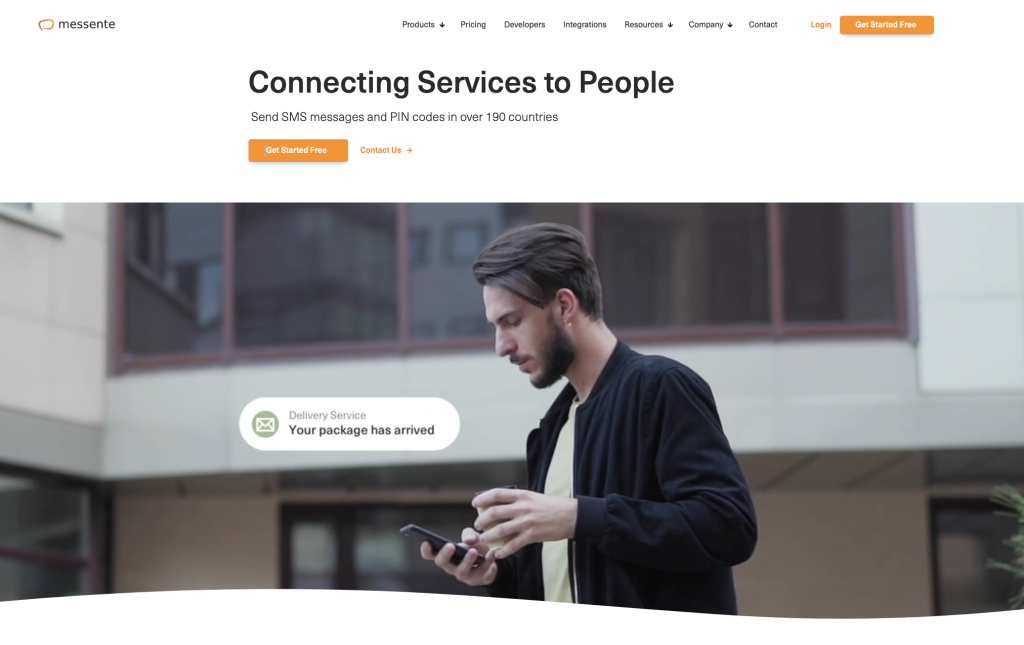How does a small company in Estonia expand to three continents in less than seven years without funding?
Last year, Messente hit €10M ARR, and they’re still growing strong. We spoke to Lauri Kinkar, Messente’s co-founder, about how they did it.
Note: If you’re expanding to new regions, we can help. Learn more about how FastSpring helps SaaS and software companies collect and remit taxes globally or localize and accept global payments.
What Is Messente?
Messente is a global messaging SaaS that helps companies send SMS messages and PIN codes in countries around the world.
Founded in 2013, Messente developed a messaging platform that originally served businesses in Estonia, Latvia, and Lithuania.
Today, Messente operates across three continents, helping companies that deal in multiple markets deliver SMS messages, regardless of their clients’ location or operator network.

How Messente started
In the early 2010s, text messaging your clients could be a lottery. Lauri was working in the telecommunication industry and wanted to send SMS messages quickly and reliably to his customers. But the platforms available at the time weren’t meeting his needs.
“There was a bit of a black box,” Lauri explained. “You could send messages, but you never knew what happened to them. Were they delivered? Were they not delivered? The whole telecom industry lacked transparency, in our opinion, and this is the problem we set out to solve.”
The solution Lauri and his partners developed became Messente — a messaging platform that allows companies to send SMS messages to their customers with full delivery reports, usage statistics, and historical data.
How Messente scaled with no funding
1. Bring a product to market quickly; start paying salaries ASAP
As a bootstrapped company, Messente was working with a tight budget initially. That meant they needed to get a product to market quickly and start securing vital income.
Working with his two co-founders, Lauri recognized an opportunity to help companies send business-critical, one-way SMS notifications to customers. They also noticed a lack of transparency and efficiency in the services that were being provided at the time and decided to fix that problem. Messente built a platform that did the job better than anything available at the time, and soon it was generating revenue within Estonia.
Lauri told us that he “would advise every company out there to see whether you can start selling as soon as possible, even just a fragment of what you’re trying to build if that already creates value. Because you’ll have a revenue stream and that gives you way more oxygen.”
In their case, the cash that Messente generated from these early sales enabled them to pay salaries quickly, which meant they could keep their doors open and the ideas flowing.
Now that they were able to survive, it was time to focus on growth.

2. One way to scale: be location-agnostic
Based in Estonia, Messente started its business with local customers but quickly spread across borders to Latvia and Lithuania. Even so, the population of those three nations combined was only two-thirds of a city like London. The founders knew that if they were going to thrive, they would have to look beyond their nearest borders.
“If you’re from a small country from a smaller market, you have to have the mindset right away that you’re not building something for your home market because it’s just too tiny,” Lauri explained. “And the next geographical region for us was Europe in general.”
Messente’s growth plan involved focusing on specific industries. In their case, it meant targeting logistics companies whose messaging and notifications strategy were a great fit for Messente’s service.
Lauri told us their strategy was to stay location-agnostic. They looked for companies throughout Europe that matched their ideal market.
“Once we got a couple of European customers on board, those customers referred us to other companies they worked with. From there, we added a few more industries to this mix, including financial services and emerging digital marketplaces.”
Messente was turning a profit month after month, meaning it could hire more salespeople and really start to scale up.
3. Expand with your customers
Expanding into new geographic markets can be costly and time-consuming, but for many SaaS companies, that’s where the growth is.
Instead of looking for hot new markets to market their services in, Messente let their customers lead.
As their customers expanded to new regions, Lauri’s team would do their homework to know how best to enter those new markets.
“If we knew that a company was going to start operating in Myanmar, for example, we had to be there a month earlier,” Lauri said. “We had to make sure our coverage to Myanmar was top-notch, and that it was tested and ready for them.”
By keeping in regular touch with clients and proactively asking them about business goals during an expansion, Messente was able to solve problems before they became an issue.
This is how they were able to expand beyond Europe into Southeast Asia, Latin America, and more than 190 countries worldwide.

This strategy worked because Messente has a long-term, loyal customer base: “I like to mention always that the first client who joined us eight years ago is still with us,” Lauri said.
Note: If you’re expanding to new countries or continents, we can help you offer each region’s preferred payment methods and currencies. Learn more about FastSpring’s global payments platform, helping SaaS and software companies transact across borders.
Lauri’s Advice for Other SaaS Leaders Looking to Grow
1. When creating a growth plan, focus on the bottom line
Lauri admits that working in a software company meant that his business is “more borderless and less capital heavy” but, as a bootstrapped company, Messente has always had to keep a close eye on the bottom line.
There are many ways that Messente could expand its services, such as offering other forms of messaging beyond SMS. While they make the most of the latest tech developments and have begun to offer services like WhatsApp’s business functionality to clients, they are also ruthless in leaving others out.
“The way we usually decide on this, is that, if we take on a new project, it means investment,” Lauri explained. “So we always ask: What’s the quickest path to actually start making money with it? In some cases, it has seemed to us that there was no quick path to revenue.”
Lauri added: “Perhaps there’s a new communication platform that sounds really fancy in terms of what they allow it to do, and maybe the user base is growing as well. But we have consciously decided that, with this one, we’re going to sit out for some time and then reassess after a year.”
This critical evaluation of what they take on has allowed Messente to continue operating with a profit.
2. Pay attention to founders’ failures as much as their successes
Lauri admits that he has benefited enormously from the close-knit tech community in Estonia where Messente began, and not just the success stories.
“In the startup community, people talk about ambition, you kind of get the idea of world dominance, talking about examples who have made it big time and had big, glittering IPOs,” he told us. “But I think listening to and creating a platform for other really great entrepreneurs out there — even if they’re struggling or in the early phases of building — having that kind of support group has helped a lot.”
By keeping in close contact with other people following the same journey, Lauri has been able to keep grounded, learn how to avoid mistakes, and understand the sometimes harsh realities of running a bootstrapped business.
“In the media, there’s a lot of talk about the more glamorous side of being an entrepreneur. But seeing the other side of it, and understanding that what’s happening to me is also happening to 1,000 other people out there as well — that is what has helped me the most.”
3. For bootstrappers, build a team with a similar mindset
To bootstrap and grow effectively, the right team is critical. You need a mix of sales and technical professionals, and since your goal is going to be to sell globally, you need diversity in your team and a mix of backgrounds.
“We started with three people in our company,” Lauri said “What worked for us in the early stages was a good mix of two technical salespeople, a very good technical founder, and a chief information officer.”
This shared mindset is vitally important: An agreed-on understanding of the purpose of the company and how to do business.
“For instance with what work ethics mean for you,” he added. “It’s terribly important between co-founders, then you move on to the rest of your core team. If you’re creating tools for the world, then you should have people with different ethnic groups building it all together. For me, the culture of the company is about mentality and, how you approach problems and how you work.”
Bootstrapped businesses don’t have the luxury of venture capital behind them meaning the team is under pressure to create a product that provides real value as fast as possible. For that, the team’s values have to be in sync with one another.
“I would say that skills are terribly important,” Lauri told us. “But on the other hand, if you can choose between someone who is a little less skilled but the match between your mindsets and how you work is better, I would perhaps prefer the person who’s a better culture match.”
![[Customer Story] Why TestDome Considers FastSpring a Real Partner](https://fastspring.com/wp-content/themes/fastspring-bamboo/images/promotional/2023/FastSpring-TestDome-blog-thumbnail.jpg)




